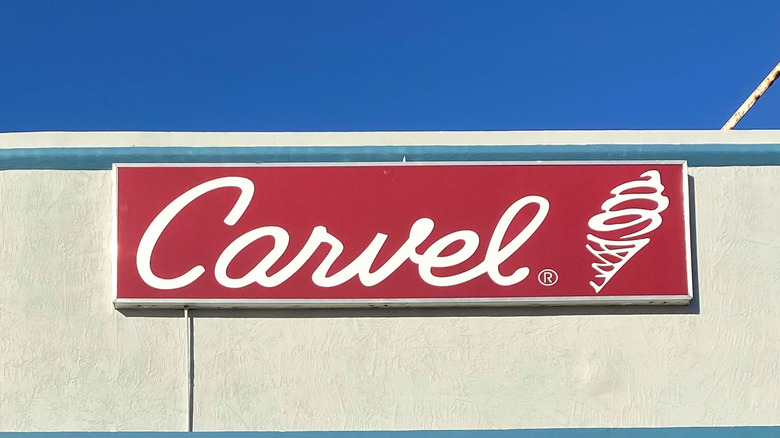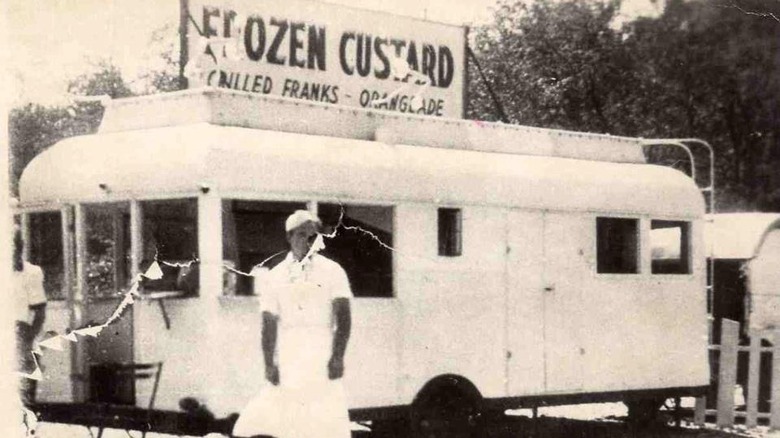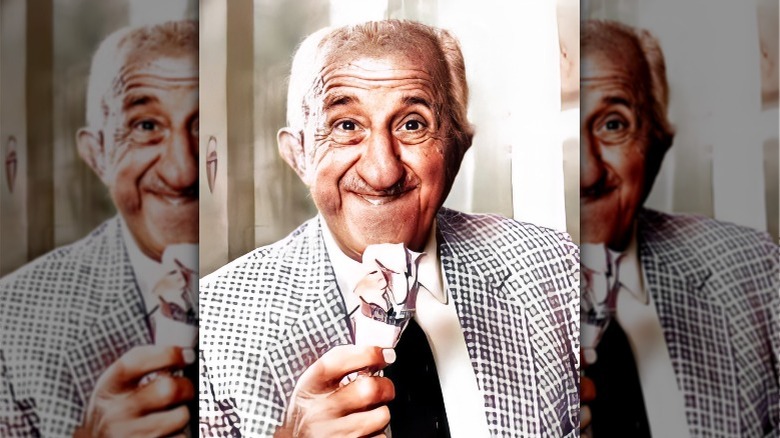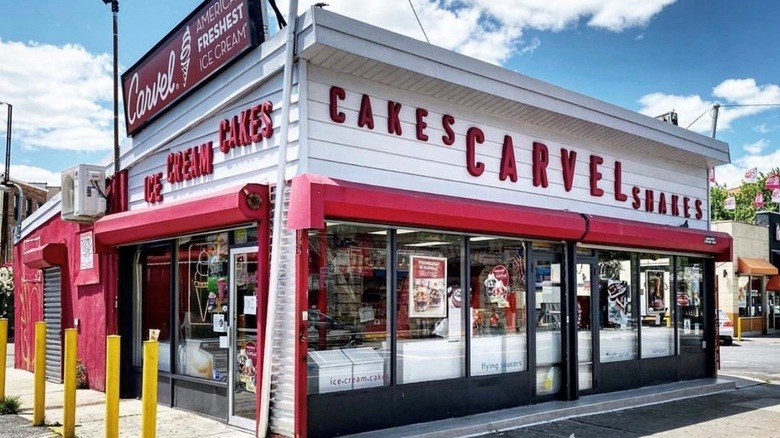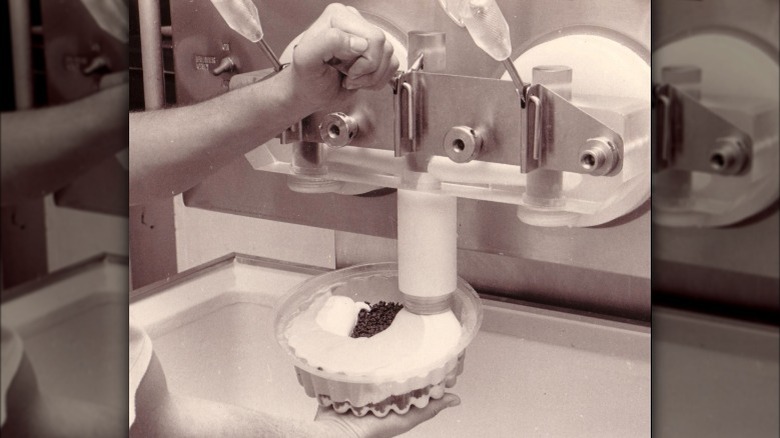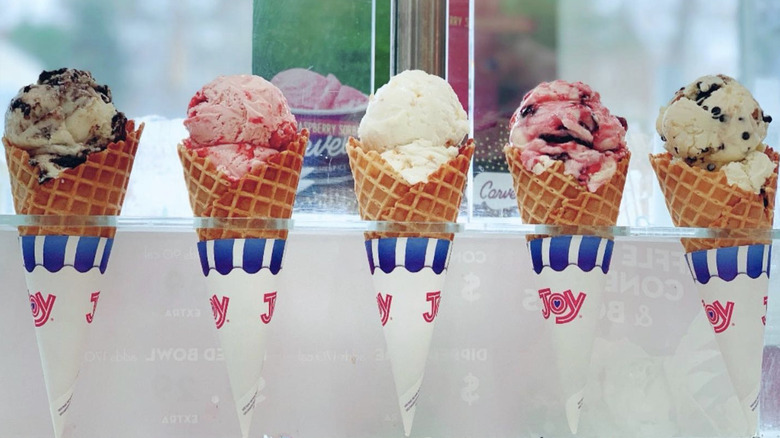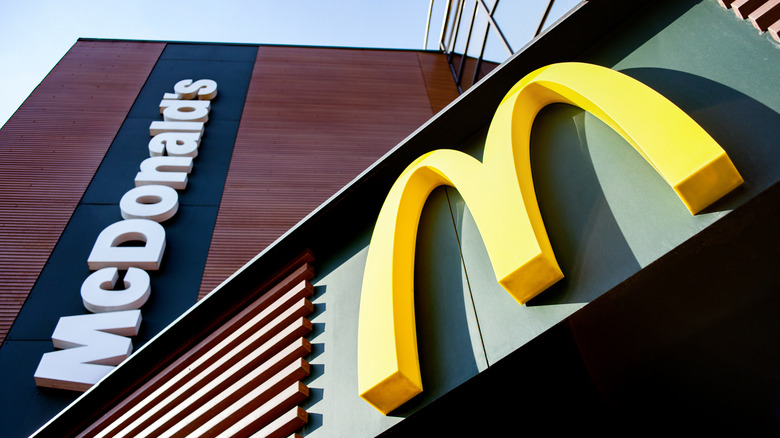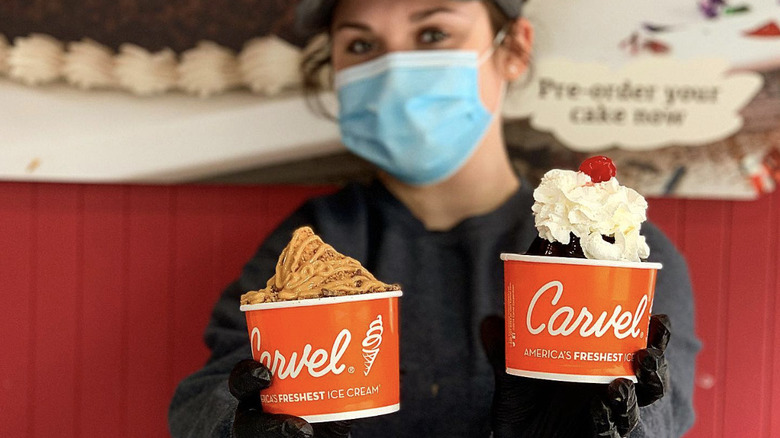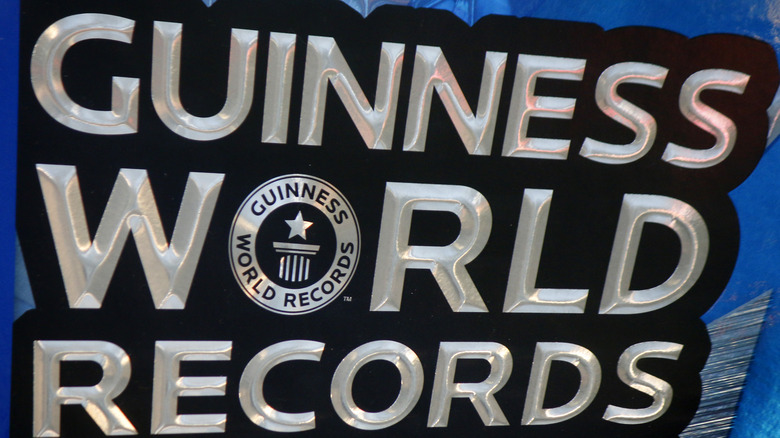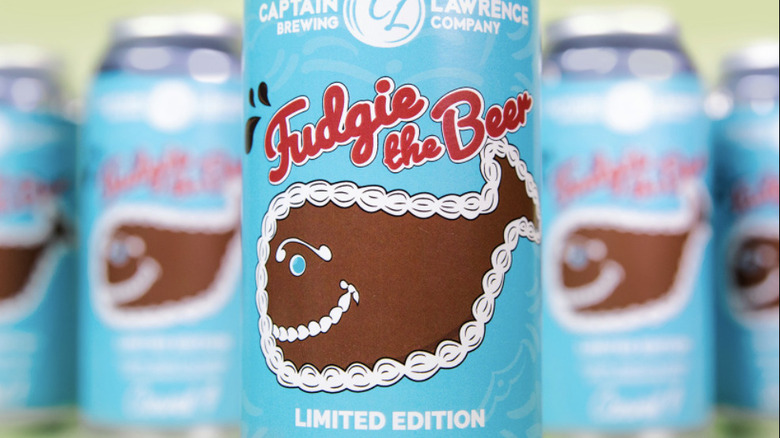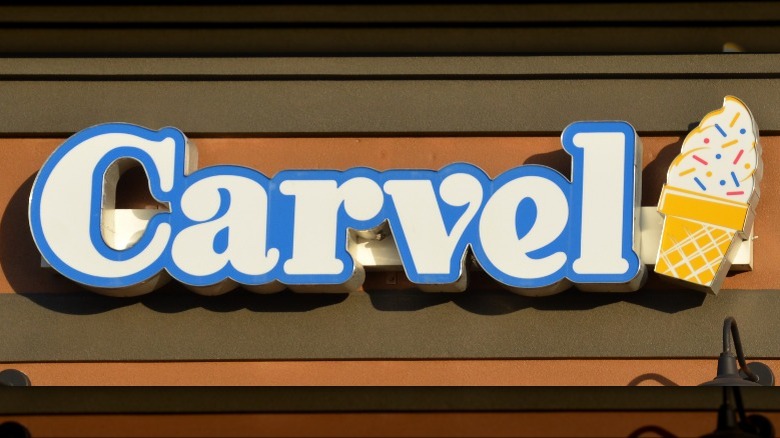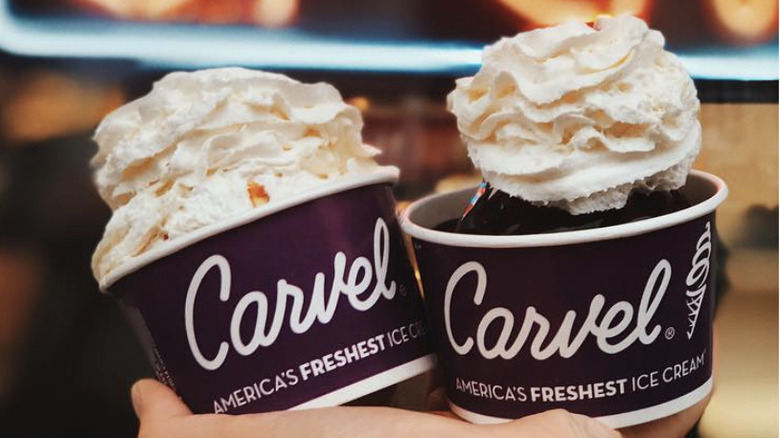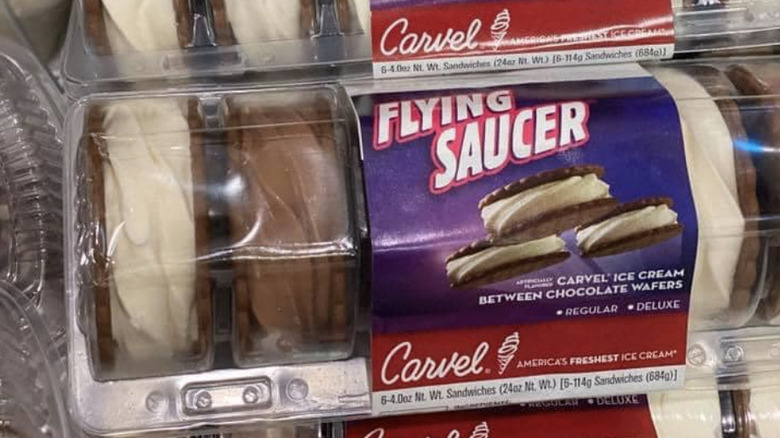The Untold Truth Of Carvel Ice Cream
The quintessential rags to riches story of Tom Carvel and his ice cream empire is as remarkable as it is dramatic. Starting out with a modest ice cream van and $20 to his name in 1929, over the years Tom meticulously built his frozen confectionery brand, which during its heyday in 1985 had 865 stores (via Funding Universe). By 2001, Carvel products could also be found in more than 5,000 supermarkets. And while Carvel changed hands before and after its founding father Tom passed away in 1990, the brand remains a cultural staple in the U.S. with over 400 locations across the country.
Incorporated in 1934, today Carvel is one of the most recognizable brands in the ice cream industry. As such, it may come as a surprise that the history of this soft-serve titan is full of twists and turns. From literal bumps in the road and cutting-edge innovations to bitter litigation and accusations of murder, Carvel has seen its fair share of ups and downs. With this in mind, here's the untold — and often surprising — truth of Carvel ice cream.
Carvel started out as an ice cream truck
While today Carvel boasts hundreds of locations across the U.S., the franchise's beginnings were indisputably humble. In fact, one of the country's most beloved chains started out in 1929 as a make-shift venture that saw its founder Tom Carvel sell ice cream — then known as custard — out of the back of a truck after borrowing $20 from his future wife to buy the necessary provisions to make the frozen treat (via Smithsonian).
On Memorial Day weekend in 1934, Tom's truck blew a tire while he was doing an ice cream run in Hartsdale, New York. As luck would have it, the nearby pottery shop owner let Tom connect to his electricity to salvage the melting ice cream. After selling out of the sweet treat in just two days, Tom realized that he could make good money from a fixed location. The future ice cream magnate made a deal with the pottery shop owner to keep the truck on his property and grossed $3,500 in his first year. Just two years later, Tom purchased the pottery store and converted it into the first Carvel ice cream shop (via Greek Herald).
Tom Carvel may have invented soft serve ice cream
The story goes that after Tom's ice cream truck hit the bump in the road that caused the flat tire, he started to sell his partially-melted ice cream to passers-by. And to his surprise, people loved the product (via America Comes Alive). Tom soon realized that his customers were particularly partial to the creamier and lighter taste of the softer ice cream (via Carvel). Spurred by the interest, the future king of soft serve decided to find a way to mass-produce the product. In 1936, he patented a machine that kept the ice cream soft enough to dispense into small cups or cones, according to the Greek Reporter.
While the Carvel website credits Tom with the invention of the soft serve ice cream we know and love today, there is another contender in the running for the title — Dairy Queen. According to the company, the franchise's founder J.F. McCullough and his son Alex developed soft serve in 1938 before obtaining a freezer that could dispense the product — an appliance invented by Harry Oltz of Hammond, Indiana. If we are to believe the dates, however, this puts Dairy Queen two years behind Carvel's invention.
Tom Carvel has been credited with pioneering the franchise business model
After developing the special freezer that would keep his soft serve at the desired temperature and consistency, in 1947 Tom went on to sell 71 of the appliances to other store owners under the name Custard King. To his dismay, Tom soon discovered that some of the new freezer owners disregarded his specific instructions regarding cleanliness and ice cream know-how. Set on making the business venture a success, Tom made the decision to oversee the freezer owners, a move he said resulted in the first ice cream franchise (via Smithsonian).
While other companies were already experimenting with the franchise business model before Tom even set up Carvel — including A&W — it does seem that he was indeed the first to franchise an ice cream shop, as the Carvel website highlights. In addition, it's been said that at one stage Tom even boasted that all franchising contracts contained "at least one paragraph" of his original contract. (via The New York Times). Whether this is true or not, it's undeniable that Tom's soft serve business was an early adopter of the American franchise model.
The Carvel College of Ice Cream Knowledge was a thing
Since restaurateurs had trouble using the freezers in a way that Tom intended, the ice cream magnate soon realized that he would need to take action to maintain product control. And that this would have to go beyond just selling equipment, supplies, recipes, and logos to aspiring business owners. Most significantly, he understood that he would have to teach new soft serve freezer owners how to run the ice cream business (via Smithsonian).
This is how the Carvel College of Ice Cream Knowledge was born. Also affectionately called the Sundae School, the college was located in the basement of The Carvel Inn in Yonkers, a motel Tom purchased and converted into the company's headquarters. This is where new franchise owners underwent 19 days of training (via The New York Times). The course curriculum included lessons about public relations, advertising, and the workings of ice cream machines. Future soft serve vendors were also given "The Shopper's Road," an in-house magazine that addressed topics such as ice cream preparation and community marketing.
Tom Carvel was a stickler for detail
Tom was known for being a strict teacher who demanded a lot from his students and future franchise owners. He is famously known for saying: "Retailing is a serious profession. You're trying to make a businessman of a non-businessman, in our case usually a couple who have saved for about 20 years. The odds that you'll succeed are about 85 percent — if you do it the way you've been trained" (via The New York Times). And while some were intimidated by his no-nonsense demeanor, others cherished the opportunity to learn and create their own rags to riches stories. William Manseau, the company's president, told The New York Times in 1985 that "you can learn more about business from [Tom] in a week than anyone else can teach you in a year.”
Realizing that cutting corners could be disastrous for his franchise empire, Tom was determined to protect his trademark. "I say you have to put three and one-half ounces into a cone. The store owner might put three ounces in to save money. Once a kid realizes he isn't getting his full cone, you've lost a customer. And that's the way you lose an entire chain. I wouldn't be in business for 50 years if I cheated the customers," he told The New York Times. Tom also had no issues with revoking the licenses of franchise owners who didn't follow his precise instructions and didn't keep their stores clean.
Tom Carvel may have said no to a McDonald's partnership
According to the Smithsonian, the founder of McDonald's, Ray Kroc, asked Tom to help him start the McDonald's franchise when the two met at a dairy convention in 1956. Tom declined the invitation since he apparently didn't feel that ice cream and hamburgers were a good match. This is surprising since he later went on to develop the franchise model for a chain called Hubie Burger. The restaurant, which served hamburgers, French fries, waffles, and chicken, was a failure. When later asked about refusing Kroc's offer, Tom apparently said that it was his "biggest error" (via Pappas Post).
Despite saying no to Kroc's offer, Tom alleged that he gave McDonald's permission to use the language of his franchise contract and certain aspects of his building design as a model, including the pitched roof and glass front. Whether this is true is questionable, as Tom Callahan pointed out in the New York Times. "Bragging is something [Tom] clearly enjoys. To hear him tell it, he taught McDonald's how to franchise. He gave Lee Iacocca pointers on filming commercials. He beat Bob Hope in golf."
Carvel is known for its iconic cake characters
Perhaps the best-known Carvel cake character, Fudgie the Whale, was born in 1977. Invented to celebrate Father's Day, the beloved pop culture icon started its life as a fish. "[Tom] wanted to make sure it was something definitely male and nothing flowery because he had just gone through Mother's Day and wanted to go in the opposite direction. He had us play with a few fish-looking cakes," Kathy Dumas, who worked with Tom for 15 years, told the New York Post. Once Tom settled on a whale, the ice cream cakes became extremely popular. "We couldn't make them fast enough that first year," Dumas said.
Before Fudgie the Whale took the spotlight, there was Cookie Puss. Invented in 1972, Cookie Puss was a light bulb-shaped ice cream cake with a cone nose that some said resembled Tom himself. Originally called Celestial Person, Cookie Puss was advertised as a friendly alien known for flying through space in a UFO. The character of Cookie Puss once even inspired a Beastie Boys song. Last but not least, Hug Me the Bear entered the scene around 1985.
Tom Carvel voiced Carvel advertisements
Carvel claims that Tom Carvel became the first CEO of a company to voice his own radio and television commercials in 1955. And despite his unique approach to grammar and unorthodox manner of speaking, the tycoon's gravelly voice certainly hit the right spot with ice cream lovers (via Democrat and Chronicle).
In fact, it's very likely that it was the down-to-earth nature of the advertising that spoke to his customers. Tom himself told the New York Times in 1985 that ”you can have a six-foot-tall handsome announcer with a perfect voice, perfect diction, perfect grammar. But very few ice-cream buyers look like that. Our commercials are for the people who look like us, talk like us, and sound like us.” In fact, Tom's advertising was so successful that he set up a production studio and an advertising agency at the company's headquarters at the Carvel Inn (via Smithsonian).
Carvel holds two Guinness World Records
From coining the "buy one, get one free" promo phrase in 1936 to masterminding promotional partnerships with the New York Yankees baseball team, Carvel has always been known for its innovative marketing ploys (via Smithsonian). And some of the chain's marketing feats have not only grabbed the attention of its customers but have also shattered two separate Guinness World Records, setting the delicious behemoth apart in the ice cream business.
In 2002, Carvel set a new world record for building the largest ice cream scoop pyramid in the world live on the CBS Early Show, per Ice Cream Reporter. The impressive structure was composed of 22 layers and 3,894 scoops of Carvel's vanilla ice cream. Standing at 53 inches, the tower was built by 28 Carvel employees in 58 minutes. The 1,005 pounds of ice cream used to construct the pyramid contained 778,800 calories and 38,940 grams of fat.
Carvel set its second Guinness World Record in 2004 when the confectionery giant constructed the largest ice cream cake to celebrate the company's 70th birthday. The frozen treat weighed 12,096 pounds and was 19 feet long, 9 feet wide, and 2 feet high. It took 54 people 75 minutes to assemble the cake with the help of ice cream sheets that were made at -120 degrees and maintained at -20 degrees in freezer trucks prior to assembly (via UPI).
Carvel released Fudgie the Beer to celebrate Father's Day
To the delight of Fudgie the Whale fans, in 2018 Carvel partnered up with Captain Lawrence Brewing to release Fudgie the Beer for Father's Day. The popular brew has since been re-released several times, even selling out on a number of occasions. So how do you combine beer and confectionery? The 6% ABV Stout-inspired ale was made with Carvel's ice cream and chocolate toppings (via Fudgie the Beer).
The full-bodied brew received a mixed to positive reception, with one Untappd reviewer saying that it's "not as sweet or novelty-tasting as I thought it'd be. Lots of chocolate, coffee, and a bit of burnt toast at the end, but kinda basic, despite all that." Another reviewer gave a more positive description of the beer: "Chocolate chip cookies in the nose pours to a deep rich black body with a spongy dark tan head. Sweet chocolate biscuits. A sharp mouthfeel that is surprising considering the style. Sweet creamy chocolate crumbles. No bitterness to speak of."
The Carvel Ice Cream fortune has been disputed
A year before his death in 1990 at the age of 84, Tom had sold his ice cream empire to an investment firm Investcorp for over $80 million, leaving behind a $67 million estate to his widow Agnes Carvel. According to Forbes, over the years several entities tried to get their hands on the fortune. It has been alleged that the disputes were caused by the excessive number of executors — there were seven in total — and poor estate planning.
According to Portfolio, shortly before his death, Tom started suspecting that his secretary Mildred Arcadipane and lawyer Robert Davis were scheming against him. Unfortunately, he passed away before getting the chance to fire them. And sure enough, with Tom out of the way, the duo began legally battling for parts of the estate. In 2007, Tom's niece Pamela Carvel went as far as filing a lawsuit, alleging that Tom was murdered by his former associates and that his body should be exhumed for an autopsy.
Despite her allegations against Tom's executors, Pamela didn't come out of the debacle clean-handed. According to the Florida Bulldog, after Agnes passed away in 1998, the litigious niece alleged that she was the heir to the estate — a claim that over the years has been dismissed by numerous state, federal and foreign courts. Pamela was also removed as one of the executors of Tom's estate after she misappropriated $2 million (via NY Daily News).
Carvel was sued for restraint of trade
In the mid-50s Tom was sued by Carvel franchise owners for unfair business practices. While Carvel won the lawsuit nine years later — and $10.5 million from the plaintiff's lawyers for unlawfully initiating the action — the litigation cost him dearly. "We were exonerated, but we lost over 70 percent of our chain ... And all of this came at a time when the franchise business in the United States was booming," Tom told The New York Times.
In 1979, the New York State Attorney General's Office brought an antitrust suit against Carvel that alleged that the company used ”harassment, extortion, [and] coercion” to force franchise owners to source their materials at inflated prices and follow set advertising campaigns. The suit was settled in 1985, with Carvel agreeing to permit franchise owners to purchase some materials from other suppliers that followed the company's exact specifications (via The New York Times).
Carvel started selling its products in grocery stores in 1992
A lot changed after Tom sold Carvel in 1989, a time when the company had around 700 stores and was the third largest ice cream venture in the U.S. after Dairy Queen and Haagen-Dazs. Aside from new headquarters and store design, Carvel started selling its products to grocery stores in 1992. And with the number of Carvel restaurants dropping to around 450, by 1998 supermarket sales constituted almost half of the company's business. While the company's sales for 1998 totaled around $200 million, $95 million of this was thanks to supermarket sales (via Funding Universe).
Franchise owners weren't happy with Carvel's decision to sell its products in grocery stores, claiming that the practice was digging into their profits (via Democrat and Chronicle). When Carvel was sold to Roark Capital in 2001, the private equity firm said that it would help the failing franchises. Nevertheless, rather than increasing the number of its franchise locations, Carvel increased its supermarket presence to 8,000 stores. Because of this, it's not surprising that according to the Small Business Administration, Carvel had a 41% failure rate on its loans in the early 2000s — much higher than Dairy Queen's 5.8% and Foster Freeze's 9% (via Startup Sapience).
